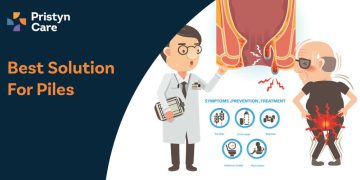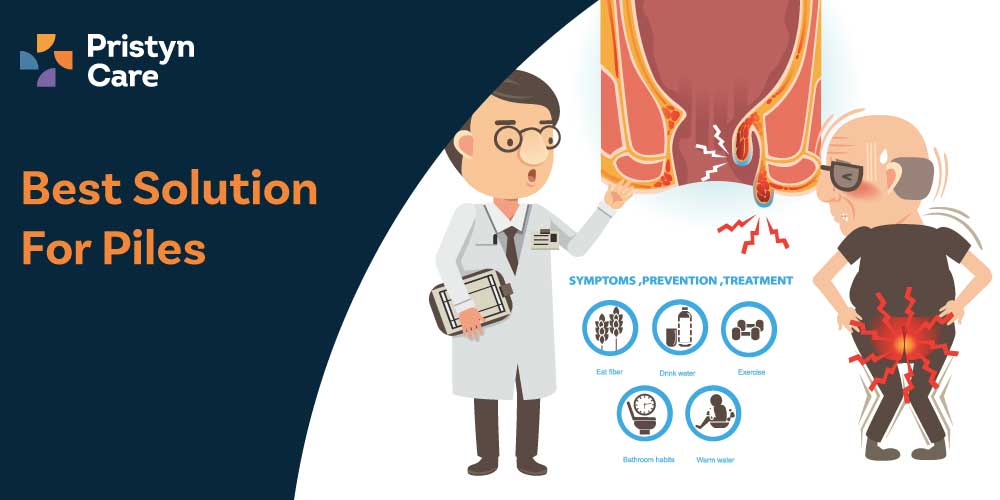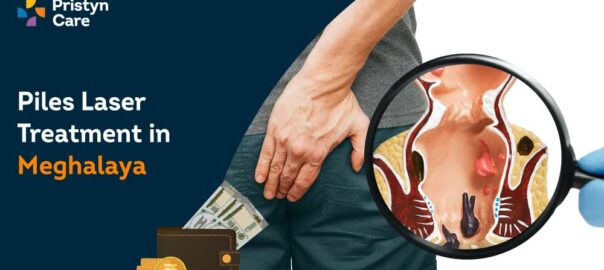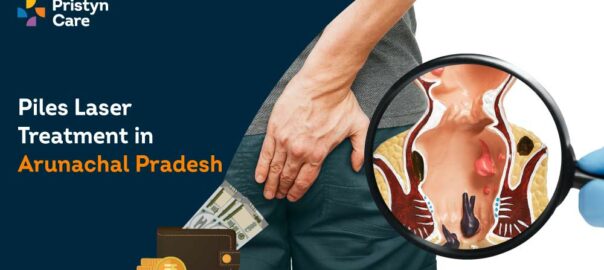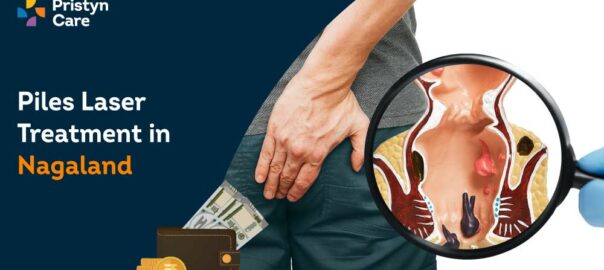![]() Views: 120
Views: 120
Best Solution For Piles
In India, piles or hemorrhoids, as they are known in medical parlance, are quite commonplace. These consist of swollen veins in the anal canal and can cause discomfort, pain, and even bleeding. They might form internally inside the rectum or externally around the anus.
Dedicated Support at Every Step!
Our Doctors are available 24 hours a day, 7 days a week to help you!
The severity of piles in India has reached a point where finding the best solutions for piles has become a necessity. This is primarily because of:
The high prevalence due to lifestyle factors such as diet and exercise routines.- The distress caused by symptoms like painful lumps around the anus, itching, discomfort during bowel movements, and blood in stool.
- The causes which range from chronic constipation, diarrhoea, heavy lifting to straining during bowel movements. Ageing, pregnancy, excess weight and a low-fibre diet also contribute.
The quest for the best treatment for piles remains ongoing as people from all walks of life are affected by this health concern.
Table of Contents
Understanding Piles
Commonly known as piles, haemorrhoids are inflamed, swollen tissues containing enlarged blood vessels found within or around the lower part of the rectum and the anus. As we age, encountering one or more symptoms associated with piles becomes increasingly common.
Causes of Piles
Essentially, piles develop when veins in your anal canal swell. This can happen due to:
- Chronic constipation or Diarrhoea: Straining during bowel movements puts pressure on these veins.
- Heavy lifting: Repeated strenuous lifting exerts pressure on these veins.
- Obesity: Extra body weight increases pressure on these veins.
- Pregnancy: The abdomen's increased pressure during pregnancy can lead to piles.
- Age: As we age, our anal canal weakens, increasing the likelihood of suffering from piles.
- Low-Fibre Diet: Consuming food low in fibre can lead to constipation and inevitable straining during bowel movements.
Primary Symptoms of Piles
The signs of piles may vary but typically include:
- Bleeding: Bright red blood may be noticed after passing stools or on toilet paper.
- Lumps: A feeling of lump either inside or around the anal area.
- Mucus discharge: Slimy mucus discharge from the anus could stain undergarments.
- Pain and Discomfort: Especially during bowel movements; exacerbated if a blood clot has formed.
- Itching and Irritation: Around the anal region.
- Swelling: Around the anal region.
- Anaemia: Consistent bleeding can result in anaemia.
Types of Piles
Piles are categorised into two main types based on their location:
- Internal Piles: Located inside the rectum, they are generally painless but may cause rectal bleeding.
- External Piles: These form small lumps on the outer edge of the anus and can cause itching and pain, particularly if a blood clot forms.
Impact on Quality of Life
Piles significantly affect an individual's wellbeing as they cause discomfort, itching, irritation, visible bleeding and disruption of regular activities. Finding the best solution for piles becomes imperative to restore one’s quality of life.
Importance of Early Diagnosis
Early diagnosis and finding the best treatment for piles are paramount. Delay in treatment might lead to severe complications such as thrombosis (blood clots causing severe pain), infections (if haemorrhoids become inflamed) or anal fistulas in severe cases.
No Cost EMI, Hassle-free Insurance Approval
Common Treatment Modalities for Piles
Piles, known medically as hemorrhoids, can be daunting to deal with. But do not worry! The medical field has made significant strides in providing the best solutions for piles. Let's delve into the various treatments available:
Non-Surgical Treatments
Before jumping straight to surgical interventions, your doctor might suggest a series of non-invasive procedures, which are generally the first line of treatment:
- Witch Hazel Pads: Applying witch hazel to the affected area can help soothe and shrink the hemorrhoids.
- Dietary Changes: To soften your stools and reduce straining during bowel movements, intake of high-fibre foods like fruits, vegetables, and whole grains is highly recommended.
- Hydration: Intense hydration can prevent constipation and make stools easier to pass.
- Over-The-Counter Creams and Ointments: Topical treatments that contain hydrocortisone could help alleviate inflammation, pain, and itching.
- Stool Softeners: Using laxatives and stool softeners can make bowel movements less strenuous.
- Warm Baths: Sitting in warm water (Sitz bath) can soothe irritation and pain associated with piles.
These measures are often effective in managing mild to moderate piles. However, if these methods fail to provide relief or if the piles advance further, it may be necessary to consider surgical treatment options.
Surgical Interventions
When dealing with advanced or recurrent piles where non-surgical treatments are ineffective, several surgical procedures might be considered as the best treatment for piles:
- Rubber Band Ligation: This involves placing a small rubber band around the base of the pile to cut off its blood supply. The pile eventually shrinks and falls off.
- Sclerotherapy: A solution is injected into the piles causing it to shrink.
- Infrared Coagulation: Small burns are created using infrared light which leads to hardening and shrinking of the pile.
- Hemorrhoidectomy: This major surgical procedure involves removing the pile itself. It usually becomes an option for large, prolapsing, or recurrent piles.
- Stapled Hemorrhoidopexy: A stapling device is used in this procedure to return the piles to their original position.
These surgical interventions are usually more effective in treating advanced or recurring piles but may carry a higher risk of complications including pain, bleeding, and infection.
Hence, the choice of treatment largely depends on the severity of the piles and the patient's personal medical history.
The Best Solution for Piles
Although piles are a common condition that can cause discomfort and pain, there isn't a one-size-fits-all solution for piles.
The best treatment plan for you wholly depends on your specific condition, the severity of your symptoms, and other personal factors.
Hence, it's essential to consider a personalised approach when seeking the best solution for piles.
Let's discuss why personalised treatment plans are vital:
- Individual Differences: Piles vary greatly from person to person. Some people might have mild symptoms while others may experience severe discomfort. Similarly, the type of piles (internal or external) also influences the choice of treatment.
- Medical History: An individual's medical history plays a vital role in deciding the best treatment for piles. For instance, if you have heart disease or diabetes, certain treatments might not be suitable.
- Personal Preferences: Patient preferences also come into play when deciding between medical interventions or lifestyle changes.
Personalised treatment plans often include the following components:
- Lifestyle Changes: Increasing physical activity can aid in managing piles by reducing pressure on the veins in your lower rectum. Activities like walking or swimming are beneficial.
- Diet Modifications: Consuming a diet high in fibre can soften stools and make them easier to pass, reducing strain during bowel movements.
- Exercise Regimes: Kegel exercises strengthen the muscles of the pelvic floor and can help alleviate the symptoms of piles.
- Medical or Surgical Interventions: Over-the-counter remedies such as creams and ointment can provide relief from minor itchiness and pain. In more severe cases, doctors might recommend procedures like rubber band ligation or surgery in an operation theatre (OT).
Remember that there is no universally "best solution for piles". Instead, working closely with your doctor or healthcare provider to create a personalised treatment plan that suits your specific situation is the most effective way to manage piles.
By combining targeted medical interventions and lifestyle changes, you can navigate this uncomfortable condition and improve your quality of life.
Conclusion
In conclusion it can be said that it's crucial to seek out suitable treatment options and adopt preventive measures for piles. However, remember, there isn't a one-size-fits-all solution, but personalised treatment plans can be your best solution for piles.
This ensures not only relief from symptoms but also helps in preventing complications. Taking these steps can lead you towards the best treatment for piles and will have a significant impact on managing this common condition effectively. So, let's prioritise our health by understanding our bodies better, choosing the right treatment for our ailments and living a healthier life.
FAQs
- What do piles look like?
Piles, also known as haemorrhoids, can manifest as an internal prolapsed or external lump near the anus. You may notice a hard, inflamed, and painful swelling here. A thrombosed haemorrhoid, which contains a blood clot, would appear dark and bluish in colour. - Are there specific foods to consume or avoid if I have haemorrhoids?
You should include more vegetables and fruits in your diet and increase your water intake, as this will help soften your stool and reduce the need to strain during bowel movements.
However, certain foods may worsen constipation and should be avoided. These include refined carbohydrates such as white flour or rice, red meat (as they are harder to digest), and spicy foods (which can exacerbate the pain of bowel movements). - How long does it take for a haemorrhoid to shrink?
The duration required for a haemorrhoid or its skin tag to shrink depends on its size. Small ones may heal within a few days whereas larger ones might take longer. Do note that haemorrhoid skin tags generally don't disappear on their own but are harmless. - What is the best treatment for piles during pregnancy?
Hormonal changes during pregnancy can cause veins to relax leading to piles due to pressure from the gravid uterus. Don't worry too much though as these usually resolve themselves post-delivery without any treatment. - How do you push haemorrhoids back in?
If a haemorrhoid is protruding outside, it's possible to gently push it back inside using a lubricating jelly. - Why do haemorrhoids itch and how can I alleviate it?
An internal prolapsed haemorrhoid often results in itching. A topical cream could provide relief in this case. - Is it true that untreated piles can turn cancerous in the long term?
No, piles will never transform into cancer. This misconception likely arises due to both conditions potentially causing rectal bleeding. However, if there's persistent bleeding, it's crucial to seek medical attention as early as possible rather than self-diagnosing or treating.



